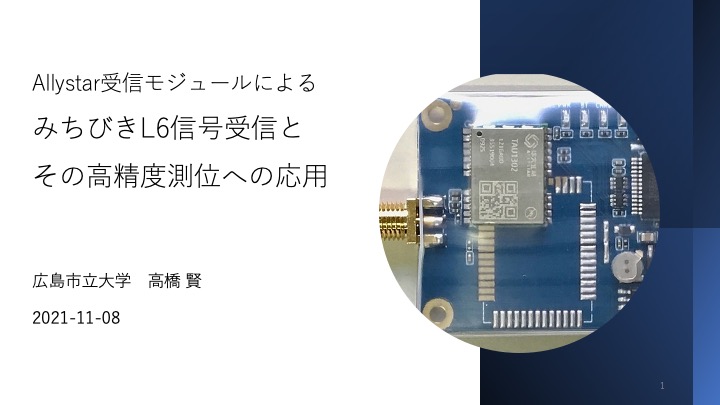Lecture on reception of QZSS positioning augmentation signal at QBIC Social Implementation Promotion WG
I gave an online lecture at the 13th meeting of the QBIC Social Implementation Promotion Working Group held on November 8, 2021.
The title of the presentation is “Reception of QZS L6 signal by Allystar receiver module and its application to high-precision positioning.” The outline is as follows:
The QZS (quasi-zenith satellite, Michibiki) L6 signal receiver, which was very expensive, is becoming popular to public. Multi-frequency antennas are also available at low prices, and I feel the future where high-precision positioning of Michibiki will become familiar. On the other hand, there are high-performance receivers on the market that utilize L6 signals, but these output only coordinate values, and I think that the true value of Michibiki is a black box. Here, we will actually receive the L6 signal with the Allystar HD9310 evaluation kit and decode the raw data.
- Receiving Michibiki’s signal is very fun.
- Not all features are implemented in state-of-the-art receivers.
- We need attention of fading in received signals in CLAS positioning. In MADOCA positioning, we require considering a correction method for ionospheric delay and tropospheric delay.
- I always appreciate everyone who has brought great technology close to us.
The questions are as follows:
- What is the rate of VRS observation data created by CLAS?
Using CLASLIB as is, it was 1 Hz. - With u-blox ZED-F9P, the signal of Michibiki should not be available.
The built-in F9P RTCM engine does not produce the observation result of the Michibiki signal. However, feeding the F9P raw data into RTKLIB, we can use the Michibiki signal! - I didn’t have much information on the Allystar chip, so it was helpful.
For utilizing Michibiki satellites for many people, I think it is important to be available to use the Michibiki signal every time and everywhere. There is an archive of Michibiki signals, but there is no real-time data available via the Internet, except for MADOCA’s paid services. It is desirable to open real-time data as well. Actually, I can publish this real-time observation data to the world just by adding two lines to my Ntrip Caster configuration file.
